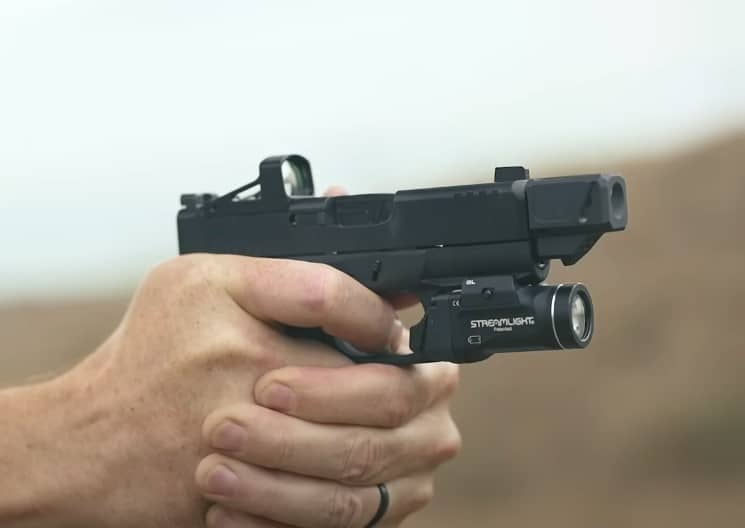A Complete Breakdown Of Lasers & Mini Red-Dots For Pistols

Pistol and revolver standard iron sights haven’t changed much since their inception. They have barely changed in the last few hundred years, going from a trench and front sight to a post and notch style.
But, of course, sights have evolved within themselves, especially post and notch sights. The addition of chemicals to create a glowing night sight, the user of fiber optics for daylight, and companies like Big Dot who produce their own style of iron sights are all a step forward, but not a revolution.
While the standard iron sight isn’t going anywhere anytime soon, we are witnessing a movement toward electronic sight options on a variety of different weapons.
The two most popular for defensive shooting are laser sights, which have grown smaller and more effective, and the newly popularized miniature red dots. These two options are growing rapidly in popularity in the pistol realm.
I want to dig into the pros and cons of these sighting options and what they can do for shooters, and what they actually offer.
Laser Sights And Grips
Lasers have seen a huge shift from what they originally were. For example, look back to a few films from the 80s, mainly the first Terminator or Tango and Cash.
The laser sights here were massive, flashlight-sized scopes that were mounted on top of the weapons.
Lasers have shrunk to a point where they are easy to carry and add almost nothing in terms of bulk or weight to the weapon. These sights also last for years on a single battery.
Style Differences
Lasers these days come in several different styles, but most are divided into two styles:
- Under mounted lasers
- Grip-based lasers.
There is an option for nearly every weapon out there, and with the power of the internet, you can most certainly find a design that suits your weapon perfectly.
Under mounted vary from lasers like the Laserlyte Sight Center Mass, which attaches to rail systems in front of the trigger guard, to the models from Laser Max that attach to the trigger guard of small weapons that lack an accessory rail.
On most full-sized weapons, these lasers are integrated into a flashlight like some models of the Streamlight TLR series. Under-mounted lasers are typically better if you want to run a flashlight on your weapon or your weapon lacks interchangeable grips.
Laser grips are most famously produced by Crimson Trace and are an excellent addition to laser grips’ red weapon. These grips are not a novelty that just contains a laser but are actually very comfortable grips and are very well made.
The laser activates as you grip the weapon, making it impossible to fail to activate the laser. These grips are made for nearly any weapon you can easily change grips on, and they even produce a line of lasers for Glock and S&W M&P pistols, which do not have interchangeable grips.
In the ‘other’ category, we have lasers that can mount in the guide rod of the trigger and lasers that attach to the rear sight. They are a little rarer but might be the right option for some people.
Uses Of Lasers
Lasers are obviously used as an aiming device, but I prefer to think of them as an aiming aid. I do believe that iron sights still rule, and lasers should only be used to complement iron sights.
People who tend to use lasers as their only aiming device are often slower on the range because they are trying to find the ‘dot.’
Lasers can also be used when shooting at nontraditional angles; at these angles, you cannot move the weapon for whatever reason to use iron sights. The laser can be used at these extreme angles in place of iron sights.
Lasers can be used as a device when you cannot use your iron sights because of light conditions. If you cannot see your iron sights, then the laser can be used exclusively to aim at your target.
In any situation in which you can use iron sights, I suggest using them. A laser is a tool in the box, but not something that should depend on.
Pros Of A Laser
- Easier to see in Low Light Situations
- Small and easy to use
- A useful aid for those with diminished vision
- Allows the user to shoot at odd angles
- It can be used as an effective training tool for trigger control
Cons Of A Laser
- Expensive, a good laser can cost around 200 dollars
- Batteries are always a con
- Worthless in bright light situations
- Dependence on the laser can reduce traditional shooting skills.
Training With A Laser Sight
Training with the laser is the most important factor in using a laser or any firearm tool. Users should train to use the laser in coordination with the iron sights. The user should not be searching for the dot but for the front sight.
Low light training is a major consideration for using these sights and should be done semi-regularly. Also, like any sight, it’s important to remember; a laser needs to be zeroed to the weapon.
Miniature Red Dot Sights
Miniature red dot sights are quickly growing in popularity for both competition shooters and those who utilize weapons for self-defense.
These optics are typically very small and use a very simple reticle. Like lasers, optics have shrunk and shrunk, going to red dot sights as small as 1.2 ounces in weight.
These sights add some bulk but little weight to the weapons they are equipped with. We are only on the eve of red dots becoming popular for handguns.
So, we haven’t seen any police or military forces adopting red dot optics on handguns, but the trend is growing. Several prominent firearms competitors and instructors keep these optics in high regard.
How To Choose One
The two big dogs in the miniature red dot sight pistol are the Leupold Delta Point and the Trijicon RMR ( we reviewed it here ). The optics are quite similar, but the Trijicon offers a wider variety of dot sizes and colors or a triangle reticle. In contrast, the Delta point offers only a 2.5 MOA red dot or a red triangle reticle.
There are also optics made by companies like Burris, Bushnell, Insight, Eotech, Aimpoint, and probably dozens of lesser-known companies.
1. The first step is to identify what you are going to use your optic and weapon for. Concealed carry and competition are two different things. Losing at a competition is losing your pride; lose in a defensive situation, and you can lose your life.
a) For a defensive pistol, you should look to a rock-solid optic and mounting solution; it just has to be, and you also want the option of retaining your iron sights.
The optic and mount should be stout enough that they can be used to rack the slide off of a belt, table, or anything else.
Finally, a weapon designed for combat needs an optic to which you can trust your life. This is where choosing a reputable company, like Trijicon or Leupold, is important. The above goes for all the home defense optics you may have.
b) A competition weapon has more leeway. You don’t NEED backup irons or a rock-solid mount. Those things are nice but not necessary in the strictest sense. You have a little extra slack.
You may not have the money to drop five hundred or more on an optic and another hundred to mill and ship the slide back and forth. So maybe a Burris Fastfire and a mount that replaces your rear sights are good enough for your competition gun.
2. Next, identify how big of a reticle you want to use. Larger reticles are better for up-close shooting and are very rapid at getting on target. A smaller dot allows for longer-range precision shooting.
A triangle reticle is another personal preference some may have for their weapon. I see larger or medium-sized dots being better for concealed carry and smaller dots being more versatile for competitors.
3. The last consideration is a big one for concealed carry, battery or no battery? Trijicon offers a battery-free miniature red dot sight that essentially absorbs light and turns it into a reticle. Trijicon is the only company I know of that offers this.
For concealed carry, this is a really good option, but if you use a battery model, all it takes is some minor attention to your optic and knowing its battery life. Whether you use a battery-powered model or not, you should have backup iron sights.
Concealed Carry
Red dot sights like the C-More systems have been used on pistols with a red dot sight in a holsterin competition for a long time, often on tricked-out 1911 race guns.
These older optics and their mounts are too large for concealed carry, but modern optics are so much smaller than concealed carry is actually a possibility.
The advantages of using a miniature red dot on a concealed carry handgun are numerous. Most holsters can accommodate a red dot sight, including most purpose-built concealed carry holsters.
A red dot offers shooters with faster target acquisition and makes shooting at longer ranges easier. Long-range shooting with a concealed carry firearm is around 25 yards and even with a larger red dot reticle, hitting a man-sized target is much easier.
When it comes to low light shooting, a miniature red dot is much easier to see, even easier to see than a handgun night sight. Also, unlike a laser sight, a miniature red dot can still work in a bright, high-light situation.
Miniature red dots with light sensors can adjust the brightness automatically, which is a huge advantage when transitioning from low light to bright areas. A miniature red dot is also easier to use for those with poor eyesight.
These red dots are easier to pick than iron sights and allow those who use glasses to still be very effective with a handgun.
The cons of such a system include price, some models’ reliance on batteries, extra bulk on a concealed weapon, and the training necessary to use the dot effectively. In addition, someone raised on iron sights will take some time to use a dot effectively.
Wrapping It Up
Miniature red dots and laser sights offer numerous advantages to the shooter. They allow the rapid acquisition, make shooting at longer distances easier, and make it possible to aim a weapon at any angle.
They can certainly complement any handgun and any owner, but they can never replace skill or talent. Both laser sights and miniature red dots offer numerous advantages over standard iron sights. However, they often come at a high price.
Unless eyesight is a factor, if you are having trouble hitting the target with iron sights, I don’t suggest running out and spending several hundred dollars on either tool.
Spend that money on ammo and training and conquer long-range shooting with iron sights before you move on to any laser aiming devices or miniature red dots.

